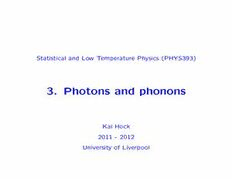
Photons and phonons PDF
Preview Photons and phonons
Statistical and Low Temperature Physics (PHYS393) 3. Photons and phonons Kai Hock 2011 - 2012 University of Liverpool Contents 3.1 Phonons 3.2 Photons 3.3 Einstein’s Model 3.4 Useful Integrals Photons and phonons 1 3.1 Phonons Photons and phonons 2 Specific heat capacities of solids Previously, we have looked at Einstein’s model of the 3-D simple harmonic oscillator, in which each atom in a solid is in its own potential well. The predicted heat capacity was accurate at high temperature, but fails at low temperature. In 1912, Peter Debye, a Dutch physicist working in Germany, produced a theory which turns out to be very accurate both hot and cold. Photons and phonons 3 Atoms vibrating in a solid In Debye’s model, we think of the atoms in a solid as connected by springs. They vibrate in 3D in a complicated way. The problem can be simplified by treating the vibration as a superposition of waves of different frequencies. If we suppose that the atoms are fixed at the edge of the solid, the frequency would be quantised. A quantum of this vibration energy is called a phonon. Photons and phonons 4 Quantised thermal waves We can count the number of states for the phonons, like we did for atoms in an ideal gas, or electrons in a metal. Unlike electrons, however, the exclusion principle does not apply to phonons. So each energy state can be occupied by any number of phonons. This means that we need yet another way to find the macrostate. This was worked out by Bose and Einstein in the 1920s. Photons and phonons 5 Bose-Einsten Statistics The method is similar to what we have used for the ideal gas. There, we have made the assumption that there are many more energy levels than there are particles. This has meant that it is unlikely for two gas atoms to occupy the same state. We do not make this assumption now, since we would be particularly interested in the low temperature behaviour. Since the exclusion principle does not apply to phonons, more than one phonons can occupy the same state. Photons and phonons 6 Bose-Einsten Statistics Suppose, in the energy bundle i, that there are g levels and n i i phonons. The phonons are now completely free to arrange themselves among the energy levels. This means that we have n + g objects altogether in the i i bundle. There are n of one type, and g of the other type. The i i number of possible arrangements would be (n + g )! i i Ω = i n !g ! i i The total number of arrangements for all bundles would be obtained by multiplication of the number for every bundle: (n + g )! (cid:89) i i Ω = . n !g ! i i i Photons and phonons 7 Bose-Einstein Distribution Then we need to maximise ln Ω using the Lagrange multiplier method. Using the same constraints as before on the number of particles N and the total energy U, the method would give the following answer: n 1 i = . g exp(−λ − λ ε ) − 1 i 1 2 i where λ and λ are the Lagrange multipliers. 1 2 This is called the Bose-Einstein distribution function. It looks almost the same as the Fermi-Dirac distribution function, except that it has -1 in the deniminator instead of +1. When we apply this to phonon, however, we need to make some changes. Photons and phonons 8 Bose-Einstein Distribution Phonons are not real particles like atoms or electrons. The number of phonons is related to the vibration energy. The number would increase when the temperature increases. At 0 Kelvin, there is no vibration, so there would be no phonons. Because of this, there would be no constraint on the number N. We really only have one constraint - that of constant energy U. The Lagrange function is ln Ω + λU. N does not appear. Maximising this function, we get n 1 i = . g exp(−λε ) − 1 i i With the help of entropy as before, we would find 1 λ = − . k T B Photons and phonons 9
